4 Levels of Effective ServiceNow® Platform Implementation
Embarking on the journey of ServiceNow® platform implementation requires a strategic approach that aligns seamlessly with organizational goals and processes. In this blog post, we delve into the intricacies of this transformative journey, uncovering the four distinct levels that characterize an effective Effective Service implementation. From the foundational level, where the groundwork is laid for future innovations, to the advanced stages that leverage the platform’s full potential, we navigate through each phase, unravelling key insights and best practices. Whether you’re a seasoned IT professional seeking to optimize workflows or a business leader aiming for enhanced efficiency, this exploration of the 4 Levels of Effective ServiceNow® Platform Implementation serves as your comprehensive guide to unlocking the platform’s capabilities and driving sustainable success within your organization. Join us as we navigate through the layers of implementation excellence, providing actionable insights that propel your ServiceNow® journey to new heights.
A quick model overview
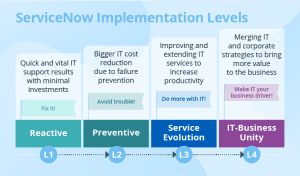

Unlock the full potential of the ServiceNow® platform with our strategic approach to implementation, structured across four distinct levels. At Level 1, we initiate a comprehensive analysis of your business processes, ensuring a solid foundation for customization. Moving to Level 2, we focus on core system configuration, leveraging out-of-the-box functionalities to align the platform with your specific requirements. Level 3 marks the integration phase, seamlessly connecting ServiceNow® with your existing IT infrastructure and other enterprise tools, fostering a unified and efficient ecosystem. Finally, at Level 4, we emphasize continuous improvement and innovation, promoting ongoing optimization, proactive maintenance, and the exploration of advanced features to keep your ServiceNow® implementation at the forefront of technological excellence. Our four-tiered approach ensures a holistic and scalable implementation, empowering your organization to harness the full capabilities of the ServiceNow® platform for enhanced productivity and service delivery.
At Level 1: Reactive
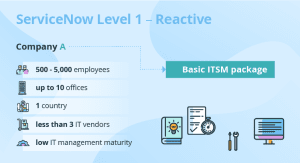

Implementing the ServiceNow® platform with a focus on reactive levels of effectiveness is a strategic approach that can significantly enhance operational efficiency and user satisfaction. Here’s a breakdown of the key elements that contribute to the reactive levels of effective ServiceNow® platform implementation:
- Incident Response Excellence: Reactive efficiency begins with a robust incident response mechanism. A well-implemented ServiceNow® platform allows organizations to swiftly identify and respond to incidents, minimizing downtime and ensuring that issues are addressed promptly. This not only improves service quality but also enhances the overall user experience.
- Real-time Monitoring and Alerts: One of the pillars of effective reactivity is the ability to monitor systems and receive real-time alerts. The ServiceNow® platform provides advanced monitoring capabilities, allowing organizations to proactively identify potential issues before they escalate. This real-time awareness enables quick decision-making and reduces the impact of disruptions.
- Automated Workflow Remediation: Implementing automated workflows on the ServiceNow® platform ensures that routine tasks and incident responses are handled promptly. This not only accelerates the resolution process but also minimizes the risk of human error. By automating repetitive tasks, organizations can focus on strategic initiatives rather than spending excessive time on manual interventions.
- User-Centric Service Desk: A reactive ServiceNow® implementation revolves around a service desk that is not just incident-centric but user-centric. The platform’s capabilities allow organizations to create a seamless and personalized experience for end-users. This includes self-service options, user-friendly interfaces, and quick query resolutions, contributing to heightened satisfaction levels.
- Continuous Improvement with Analytics: Leveraging the analytics and reporting features of the ServiceNow® platform is crucial for reactive effectiveness. Organizations can analyze incident trends, identify recurring issues, and implement preventive measures. This data-driven approach ensures continuous improvement in service delivery and positions the organization to respond proactively to emerging challenges.
- Adaptability to Change: Reactivity in the ServiceNow® context is not just about responding to incidents but also adapting to changing business requirements. A well-implemented platform should be flexible and scalable, allowing organizations to modify workflows, introduce new services, and integrate seamlessly with evolving technologies, ensuring long-term effectiveness.
- User Training and Adoption Programs: To maximize the reactive levels of the ServiceNow® platform, organizations should invest in comprehensive user training and adoption programs. Ensuring that all stakeholders are proficient in utilizing the platform’s features empowers them to make the most of its capabilities, leading to faster issue resolution and increased operational agility.
In conclusion, adopting a reactive approach to ServiceNow® platform implementation is a strategic move towards a more agile and responsive IT service management environment. By focusing on incident response, real-time monitoring, automation, user-centric service delivery, analytics, adaptability, and user proficiency, organizations can unlock the full potential of the ServiceNow® platform in enhancing overall operational efficiency and service quality.
Preventive Levels of Effective ServiceNow® Platform Implementation:
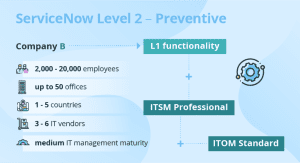

Implementing the ServiceNow® platform is a transformative step for organizations seeking to optimize their workflows and enhance overall efficiency. To ensure a seamless integration and ongoing success, a proactive approach at various levels of implementation is crucial. Here are the preventive measures that contribute to the effectiveness of ServiceNow® platform implementation:
Comprehensive Needs Assessment:
- Before embarking on the implementation journey, conduct a thorough assessment of your organization’s unique needs and challenges. Understanding the specific requirements allows for a tailored configuration of the ServiceNow® platform, minimizing the risk of overlooking critical functionalities.
Stakeholder Involvement and Communication:
- Effective communication and involving stakeholders from various departments are vital components of successful implementation. Keeping all relevant parties informed and engaged helps in preventing misunderstandings, resistance to change, and ensures that the platform aligns with the diverse needs of the organization.
Robust Training Programs:
- Prevention begins with education. Investing in comprehensive training programs for users at all levels is essential. This proactive measure ensures that employees are well-equipped to navigate the ServiceNow® platform, reducing the likelihood of errors, and maximizing the platform’s potential for productivity gains.
Continuous Testing Protocols:
- Implementing a robust testing strategy is a preventive measure that catches potential issues before they become critical. Regularly test configurations, workflows, and integrations to identify and address any discrepancies, ensuring a stable and reliable ServiceNow® environment.
Security Best Practices:
- Security is paramount in any digital transformation. Implementing preventive security measures, such as adherence to industry best practices, regular security audits, and user access controls, safeguards sensitive data and protects the organization from potential cyber threats.
Scalability Planning:
- Anticipating future growth and changes in organizational dynamics is key to preventive implementation. Design the ServiceNow® platform with scalability in mind, ensuring it can accommodate increased data loads, users, and additional functionalities without compromising performance.
Regular Platform Updates and Maintenance:
- ServiceNow® regularly releases updates and enhancements to improve functionality and security. Staying proactive in applying these updates and conducting routine maintenance ensures that the platform operates at peak efficiency, and organizations benefit from the latest features and security patches.
Feedback Mechanisms:
- Establishing feedback mechanisms allows users to report issues and suggest improvements. Proactively addressing feedback contributes to continuous improvement and user satisfaction, creating an environment where the ServiceNow® platform evolves in tandem with the organization’s changing needs.
In conclusion, the preventive levels of effective ServiceNow® platform implementation involve a strategic, proactive, and comprehensive approach. By addressing potential challenges before they escalate, organizations can maximize the benefits of the ServiceNow® platform, fostering a culture of efficiency, collaboration, and innovation.
Preventive Service Evolution: Level of Effective ServiceNow® Platform Implementation:
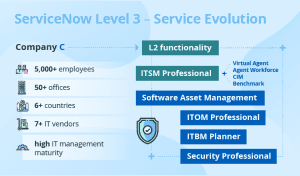

In the rapidly evolving landscape of service management, the implementation of the Effective Service platform has become synonymous with a proactive and preventive approach to service delivery. This transformative technology doesn’t just manage incidents but reshapes the entire service ecosystem. Let’s delve into the different levels of effective implementation that mark the evolution of preventive services through the ServiceNow® platform.
- Foundation Level: Laying the Groundwork for Prevention
At the foundation level, organizations initiate their Effective Service journey by establishing a robust framework for incident management. This involves setting up a centralized system for logging and tracking issues, creating a baseline for service awareness. This foundational step is crucial, as it forms the backbone for more advanced preventive measures.
- Automation Proficiency: Streamlining Operations for Proactive Intervention
As organizations move to the next level, they leverage the power of automation within the ServiceNow® platform. This entails the automation of routine tasks, enabling the system to detect and resolve issues before they impact users. Automated incident response, intelligent routing, and self-healing capabilities become key components, contributing to a more proactive and efficient service model.
-
Predictive Analytics Integration: Anticipating Issues Before They Occur
The evolution continues with the integration of predictive analytics. By harnessing the data collected within the ServiceNow® platform, organizations can predict potential service disruptions before they manifest. Machine learning algorithms analyze historical data patterns, allowing for the identification of trends and potential areas of concern. This level of foresight empowers service teams to address issues at their root, preventing future incidents.
- Continuous Improvement and Learning: Adapting in Real Time
The most advanced stage of preventive service evolution involves continuous learning and improvement. Organizations at this level use the Effective Service platform not just as a static tool but as a dynamic learning system. Machine learning algorithms continuously adapt and refine based on real-time data, ensuring that the preventive measures stay ahead of evolving challenges. This adaptive approach enables organizations to stay resilient in the face of changing service landscapes.
Conclusion: Shaping the Future of Service Management
The evolution of preventive services through the Effective Service platform is a journey that transforms organizations from reactive problem solvers to proactive service innovators. By embracing automation, predictive analytics, and continuous learning, businesses can not only prevent disruptions but also shape the future of service management, creating a resilient and agile service ecosystem. As technology advances, the ServiceNow® platform stands as a beacon for organizations seeking to stay ahead in the dynamic and demanding world of service delivery.
Level 4 – IT-Business Unity:
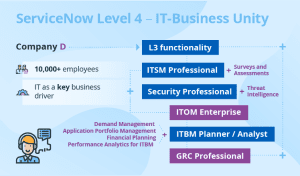

In the dynamic landscape of contemporary business operations. The symbiotic relationship between Information Technology (IT) and business units has undergone a transformative evolution. A pivotal player in this paradigm shift is the implementation of the Effective Service platform. A versatile solution designed to streamline processes, enhance collaboration, and elevate overall efficiency. As organizations embark on this journey of IT-business unity through ServiceNow®, distinct evolutionary levels emerge, each marking a milestone in the pursuit of effective digital transformation.
- Foundation Establishment:
The initial stage in the IT-Business Unity Evolution involves laying the foundation for Effective Service implementation. This phase encompasses comprehensive planning, stakeholder engagement, and an in-depth analysis of organizational needs. Establishing a robust foundation ensures that the subsequent stages are built on a solid framework. Aligning the ServiceNow® platform with the unique objectives and challenges of the business.
-
Seamless Integration:
The evolution progresses with the seamless integration of the Effective Service platform into existing IT infrastructure and business processes. This level focuses on interoperability, ensuring that the platform acts as a cohesive force. Connecting disparate systems and fostering a unified digital ecosystem. Successful integration facilitates real-time data sharing, reducing silos and enhancing cross-functional collaboration.
- Process Optimization and Automation:
As organizations mature in their ServiceNow® implementation, the focus shifts towards optimizing and automating critical business processes. This involves leveraging the platform’s workflow capabilities to enhance efficiency, reduce manual intervention, and minimize the margin for error. By automating routine tasks, businesses can redirect resources towards strategic initiatives, fostering agility and innovation.
- Enhanced User Experience:
The evolution reaches a pivotal point with a heightened emphasis on user experience. Organizations recognize the significance of a user-friendly interface and seamless interaction with the Effective Service platform. Customization, intuitive design, and user-centric features become paramount. Ensuring that employees across the spectrum find value in the platform, thereby increasing overall adoption and maximizing its impact.
- Data-Driven Decision Making:
At the zenith of IT-business unity evolution, organizations leverage the rich data generated by the ServiceNow® platform for informed decision-making. Advanced analytics and reporting capabilities empower stakeholders to glean insights into operational performance. Identify areas for improvement, and make strategic decisions backed by data-driven intelligence. This level of sophistication transforms the ServiceNow® platform into a strategic asset that catalyzes innovation and continuous improvement.
In essence, the journey through the evolutionary levels of ServiceNow® platform implementation represents a commitment to fostering IT-business unity. It is a testament to the organization’s adaptability, innovation, and strategic vision. Ultimately leading to a more agile, collaborative, and future-ready business ecosystem.
